Port Emissions Assessment: Integrating Emission Measurements and AIS Data for Comprehensive Analysis
Abstract
:1. Introduction
2. Materials and Methods
2.1. The Port of Naples
2.2. Experimental Campaign
3. Results
3.1. Meteorological Conditions
3.2. Ship Traffic
3.3. Time Pattern
4. Conclusions
Author Contributions
Funding
Institutional Review Board Statement
Informed Consent Statement
Data Availability Statement
Acknowledgments
Conflicts of Interest
References
- Toscano, D. The Impact of Shipping on Air Quality in the Port Cities of the Mediterranean Area: A Review. Atmosphere 2023, 14, 1180. [Google Scholar] [CrossRef]
- Liu, Z.; Lu, X.; Feng, J.; Fan, Q.; Zhang, Y.; Yang, X. Influence of ship emissions on urban air quality: A comprehensive study using highly time-resolved online measurements and numerical simulation in Shanghai. Environ. Sci. Technol. 2017, 51, 202–211. [Google Scholar] [CrossRef] [PubMed]
- Mueller, D.; Uibel, S.; Takemura, M.; Klingelhoefer, D.; Groneberg, D.A. Ships, ports and particulate air pollution—An analysis of recent studies. J. Occup. Med. Toxicol. 2011, 6, 1–6. [Google Scholar] [CrossRef]
- Wang, X.; Shen, Y.; Lin, Y.; Pan, J.; Zhang, Y.; Louie, P.K.K.; Li, M.; Fu, Q. Atmospheric pollution from ships and its impact on local air quality at a port site in Shanghai. Atmos. Chem. Phys. 2019, 19, 6315–6330. [Google Scholar] [CrossRef]
- Zhang, Y.; Yang, X.; Brown, R.; Yang, L.; Morawska, L.; Ristovski, Z.; Fu, Q.; Huang, C. Shipping emissions and their impacts on air quality in China. Sci. Total. Environ. 2017, 581–582, 186–198. [Google Scholar] [CrossRef] [PubMed]
- Tao, L.; Fairley, D.; Kleeman, M.J.; Harley, R.A. Effects of switching to lower sulfur marine fuel oil on air quality in the San Francisco Bay area. Environ. Sci. Technol. 2013, 47, 10171–10178. [Google Scholar] [CrossRef] [PubMed]
- Corbett, J.J.; Winebrake, J.J.; Green, E.H.; Kasibhatla, P.; Eyring, V.; Lauer, A. Mortality from ship emissions: A global assessment. Environ. Sci. Technol. 2007, 41, 8512–8518. [Google Scholar] [CrossRef] [PubMed]
- Corbett, J.J.; Koehler, H.W. Updated emissions from ocean shipping. J. Geophys. Res. Atmos. 2003, 108. [Google Scholar] [CrossRef]
- De Meyer, P.; Maes, F.; Volckaert, A. Emissions from international shipping in the Belgian part of the North Sea and the Belgian seaports. Atmos. Environ. 2008, 42, 196–206. [Google Scholar] [CrossRef]
- Eyring, V.; Köhler, H.W.; Van Aardenne, J.; Lauer, A. Emissions from international shipping: 1. The last 50 years. J. Geophys. Res. Atmos. 2005, 110. [Google Scholar] [CrossRef]
- IMO. Third IMO Greenhouse Gas Study 2014: Executive Summary and Final Report; International Maritime Organization: London, UK, 2015. [Google Scholar]
- Schrooten, L.; De Vlieger, I.; Panis, L.I.; Styns, K.; Torfs, R. Inventory and forecasting of maritime emissions in the Belgian sea territory, an activity-based emission model. Atmos. Environ. 2008, 42, 667–676. [Google Scholar] [CrossRef]
- Agrawal, H.; Welch, W.A.; Henningsen, S.; Miller, J.W.; Cocker III, D.R. Emissions from main propulsion engine on container ship at sea. J. Geophys. Res. Atmos. 2010, 115. [Google Scholar] [CrossRef]
- Chen, D.; Zhao, Y.; Nelson, P.; Li, Y.; Wang, X.; Zhou, Y.; Lang, J.; Guo, X. Estimating ship emissions based on AIS data for port of Tianjin, China. Atmos. Environ. 2016, 145, 10–18. [Google Scholar] [CrossRef]
- Passig, J.; Schade, J.; Irsig, R.; Li, L.; Li, X.; Zhou, Z.; Adam, T.; Zimmermann, R. Detection of ship plumes from residual fuel operation in emission control areas using single-particle mass spectrometry. Atmos. Meas. Tech. 2021, 14, 4171–4185. [Google Scholar] [CrossRef]
- Schalm, O.; Carro, G.; Lazarov, B.; Jacobs, W.; Stranger, M. Reliability of lower-cost sensors in the analysis of indoor air quality on board ships. Atmosphere 2022, 13, 1579. [Google Scholar] [CrossRef]
- Pillot, D.; Guiot, B.; Le Cottier, P.; Perret, P.; Tassel, P. Exhaust emissions from in-service inland waterways vessels. In TAP 2016, 21st International Transport and Air Pollution Conference; Scienpress Ltd.: Christchurch, New Zealand, 2016; Volume 6, p. 205. [Google Scholar]
- Van Roy, W.; Scheldeman, K.; Van Roozendael, B.; Van Nieuwenhove, A.; Schallier, R.; Vigin, L.; Maes, F. Airborne monitoring of compliance to NOx emission regulations from ocean-going vessels in the Belgian North Sea. Atmos. Pollut. Res. 2022, 13, 101518. [Google Scholar] [CrossRef]
- Ekmekçioğlu, A.; Kuzu, S.L.; Ünlügençoğlu, K.; Çelebi, U.B. Assessment of shipping emission factors through monitoring and modelling studies. Sci. Total. Environ. 2020, 743, 140742. [Google Scholar] [CrossRef] [PubMed]
- Murat, D.; Kalender, S.S.; Ergin, S. Experimental study on the effects of ultra-low sulfur diesel fuel to the exhaust emissions of a ferry. Fresenius Environ. Bull. 2017, 26, 5833–5840. [Google Scholar]
- Aulinger, A.; Matthias, V.; Zeretzke, M.; Bieser, J.; Quante, M.; Backes, A. The impact of shipping emissions on air pollution in the greater North Sea region—Part 1: Current emissions and concentrations. Part 1: Current emissions and concentrations. Atmos. Chem. Phys. 2016, 16, 739–758. [Google Scholar] [CrossRef]
- Goldsworthy, L.; Goldsworthy, B. Modelling of ship engine exhaust emissions in ports and extensive coastal waters based on terrestrial AIS data—An Australian case study. Environ. Model. Softw. 2015, 63, 45–60. [Google Scholar] [CrossRef]
- Simonsen, M.; Walnum, H.J.; Gössling, S. Model for Estimation of Fuel Consumption of Cruise Ships. Energies 2018, 11, 1059. [Google Scholar] [CrossRef]
- Feng, J.; Zhang, Y.; Li, S.; Mao, J.; Patton, A.P.; Zhou, Y.; Ma, W.; Liu, C.; Kan, H.; Huang, C.; et al. The influence of spatiality on shipping emissions, air quality and potential human exposure in the Yangtze River Delta/Shanghai, China. Atmos. Chem. Phys. 2019, 19, 6167–6183. [Google Scholar] [CrossRef]
- Merico, E.; Dinoi, A.; Contini, D. Development of an integrated modelling-measurement system for near-real-time estimates of harbour activity impact to atmospheric pollution in coastal cities. Transp. Res. Part D Transp. Environ. 2019, 73, 108–119. [Google Scholar] [CrossRef]
- Monteiro, A.; Russo, M.; Gama, C.; Borrego, C. How important are maritime emissions for the air quality: At European and national scale. Environ. Pollut. 2018, 242, 565–575. [Google Scholar] [CrossRef] [PubMed]
- Murena, F.; Mocerino, L.; Quaranta, F.; Toscano, D. Impact on air quality of cruise ship emissions in Naples, Italy. Atmos. Environ. 2018, 187, 70–83. [Google Scholar] [CrossRef]
- Ramacher, M.O.P.; Matthias, V.; Aulinger, A.; Quante, M.; Bieser, J.; Karl, M. Contributions of traffic and shipping emissions to city-scale NOx and PM2.5 exposure in Hamburg. Atmos. Environ. 2020, 237, 117674. [Google Scholar] [CrossRef]
- Contini, D.; Gambaro, A.; Belosi, F.; De Pieri, S.; Cairns, W.; Donateo, A.; Zanotto, E.; Citron, M. The direct influence of ship traffic on atmospheric PM2.5, PM10 and PAH in Venice. J. Environ. Manag. 2011, 92, 2119–2129. [Google Scholar] [CrossRef]
- Mocerino, L.; Rizzuto, E. Preliminary approach to the application of the environmental ship index. In Sustainable Development and Innovations in Marine Technologies: Proceedings of the 18th International Congress of the Maritme Association of the Mediterranean (IMAM 2019), Varna, Bulgaria, 9–11 September 2019; CRC Press: Boca Raton, FL, USA, 2019; p. 285. [Google Scholar]
- Available online: https://adsptirrenocentrale.it/wp-content/uploads/2023/03/12_Bollettino-statistico-12-mesi-2022.pdf (accessed on 31 January 2024).
- Ledoux, F.; Roche, C.; Cazier, F.; Beaugard, C.; Courcot, D. Influence of ship emissions on NOx, SO2, O3 and PM concentrations in a North-Sea harbor in France. J. Environ. Sci. 2018, 71, 56–66. [Google Scholar] [CrossRef]
- Toscano, D.; Murena, F.; Quaranta, F.; Mocerino, L. Assessment of the impact of ship emissions on air quality based on a complete annual emission inventory using AIS data for the port of Naples. Ocean Eng. 2021, 232, 109166. [Google Scholar] [CrossRef]
- Toscano, D.; Murena, F.; Quaranta, F.; Mocerino, L. Impact of ship emissions at a high receptor point in the port of Naples. Atmos. Environ. 2022, 286, 119253. [Google Scholar] [CrossRef]
- Mocerino, L.; Murena, F.; Quaranta, F.; Toscano, D. Validation of the estimated ships’ emissions through an exper-imental campaign in port. Ocean Eng. 2023, 288, 115957. [Google Scholar] [CrossRef]
- Schwarzkopf, D.A.; Petrik, R.; Matthias, V.; Quante, M.; Majamäki, E.; Jalkanen, J.-P. A ship emission modeling system with scenario capabilities. Atmos. Environ. X 2021, 12, 100132. [Google Scholar] [CrossRef]
- Mocerino, L.; Murena, F.; Quaranta, F.; Toscano, D. A methodology for the design of an effective air quality moni-toring network in port areas. Sci. Rep. 2020, 10, 300. [Google Scholar] [CrossRef]
- Carratelli, E.P.; Budillon, G.; Dentale, F.; Napoli, F.; Reale, F.; Spulsi, G. An experience in monitoring and integrating wind and wave data in the Campania Region. Boll. Geofis. Teor. Appl. 2007, 48, 215–226. [Google Scholar]
- Eyring, V.; Stevenson, D.S.; Lauer, A.; Dentener, F.J.; Butler, T.; Collins, W.J.; Ellingsen, K.; Gauss, M.; Hauglustaine, D.A.; Isaksen, I.S.A.; et al. Multi-model simulations of the impact of international shipping on Atmospheric Chemistry and Climate in 2000 and 2030. Atmos. Chem. Phys. 2007, 7, 757–780. [Google Scholar] [CrossRef]
- Johansson, L.; Jalkanen, J.-P.; Kukkonen, J. Global assessment of shipping emissions in 2015 on a high spatial and temporal resolution. Atmos. Environ. 2017, 167, 403–415. [Google Scholar] [CrossRef]
- Fridell, E.; Steen, E.; Peterson, K. Primary particles in ship emissions. Atmos. Environ. 2008, 42, 1160–1168. [Google Scholar] [CrossRef]
- Fridell, E. Emissions and fuel use in the shipping sector. In Green Ports; Elsevier: Amsterdam, The Netherlands, 2019; pp. 19–33. [Google Scholar]

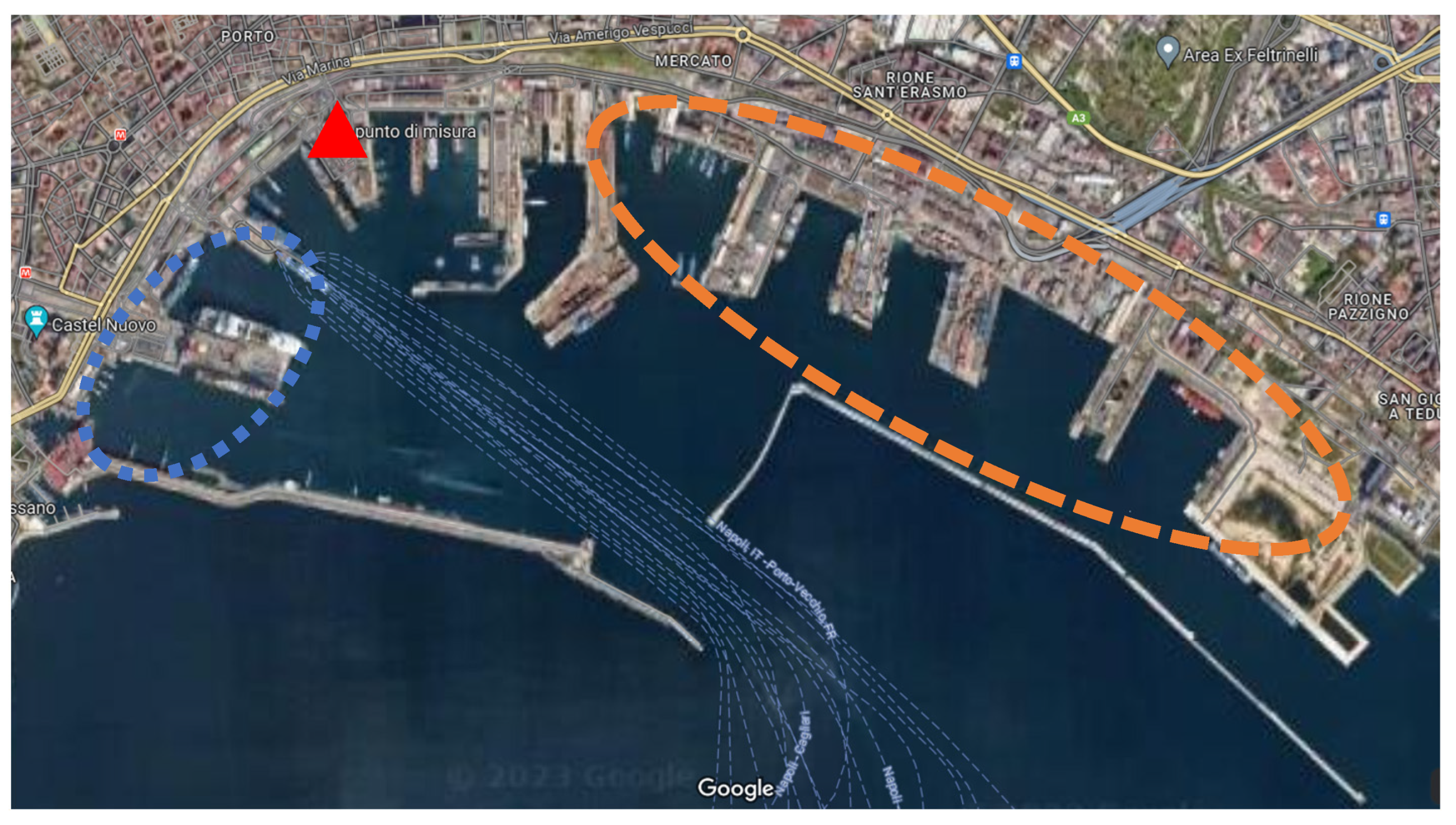

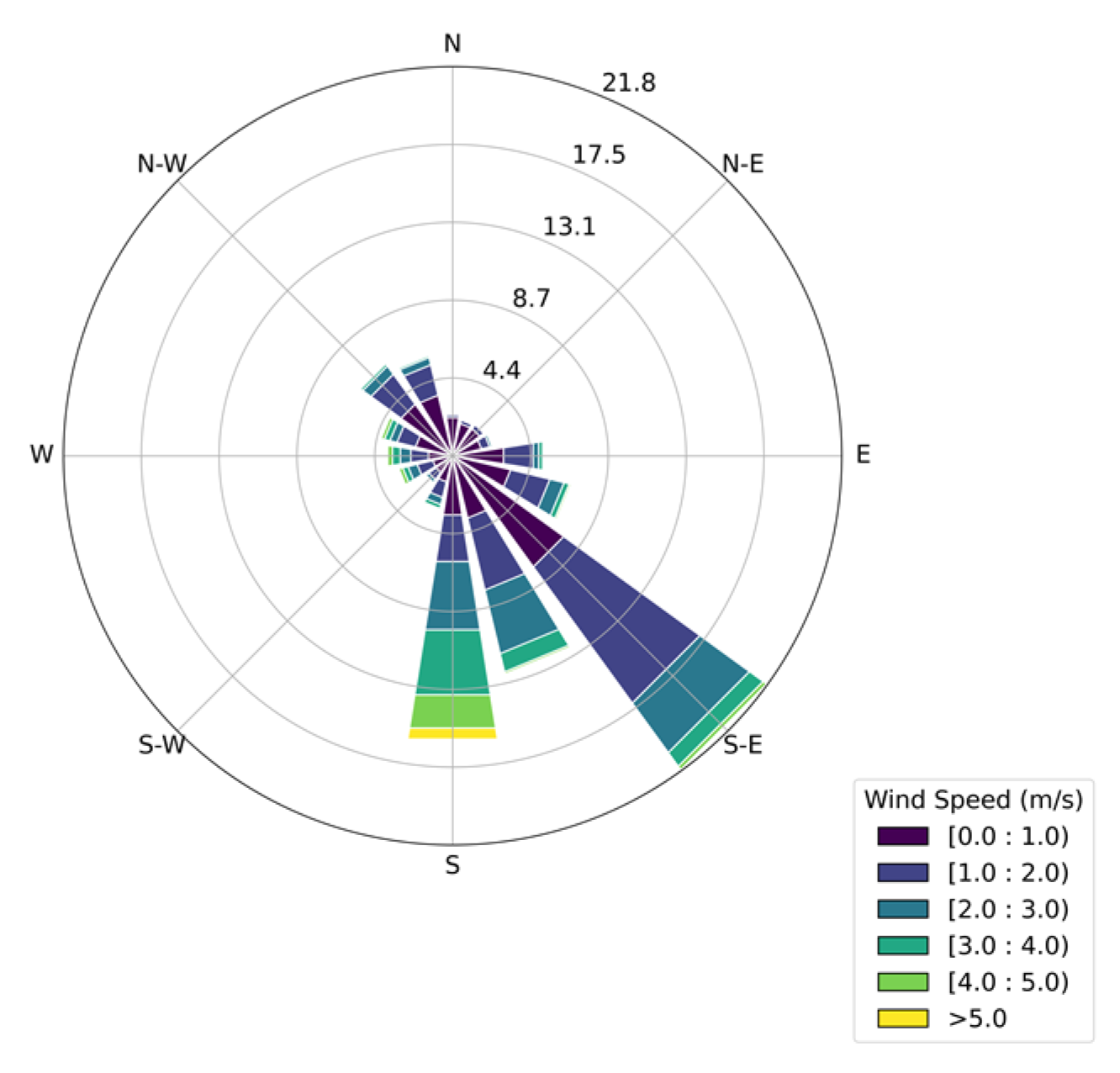

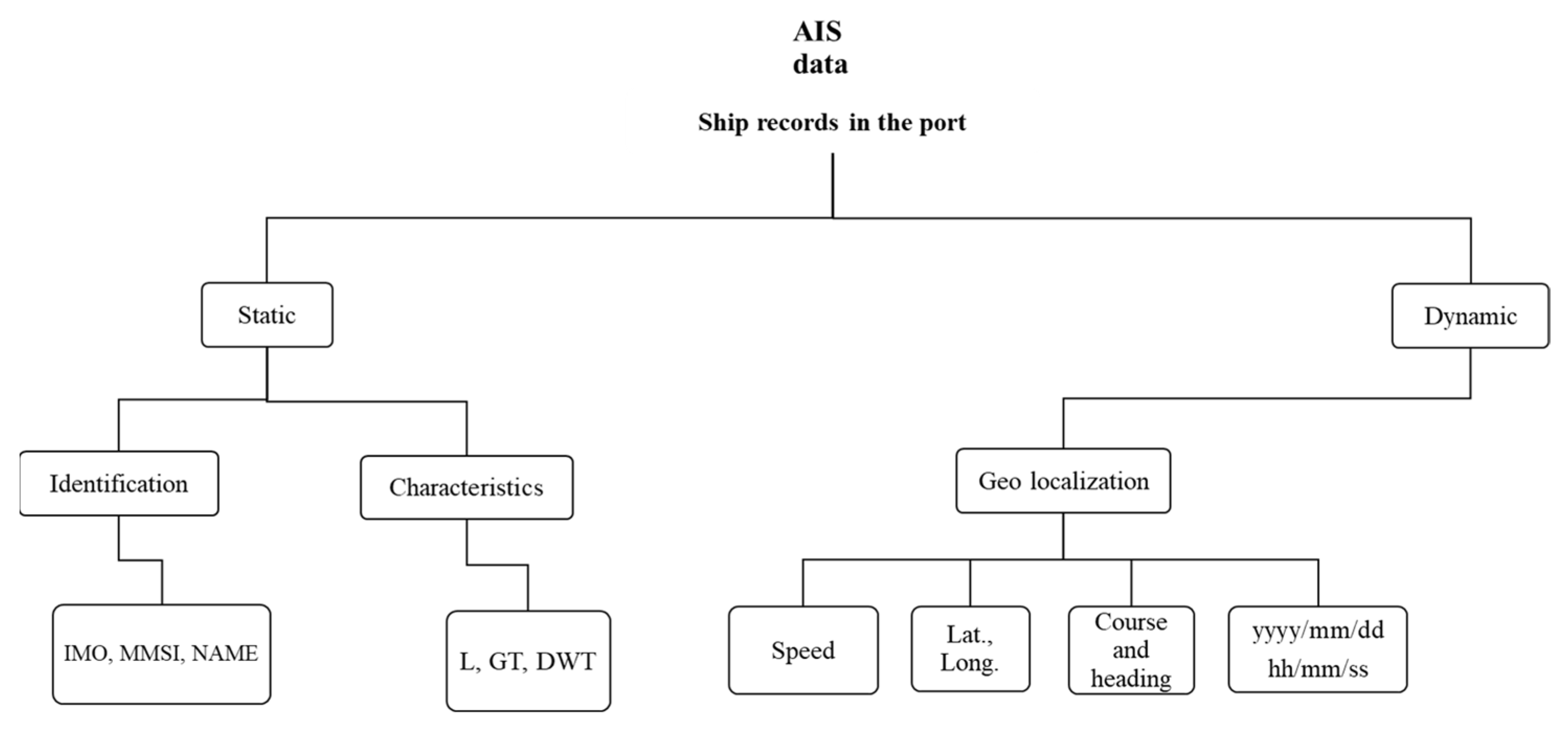
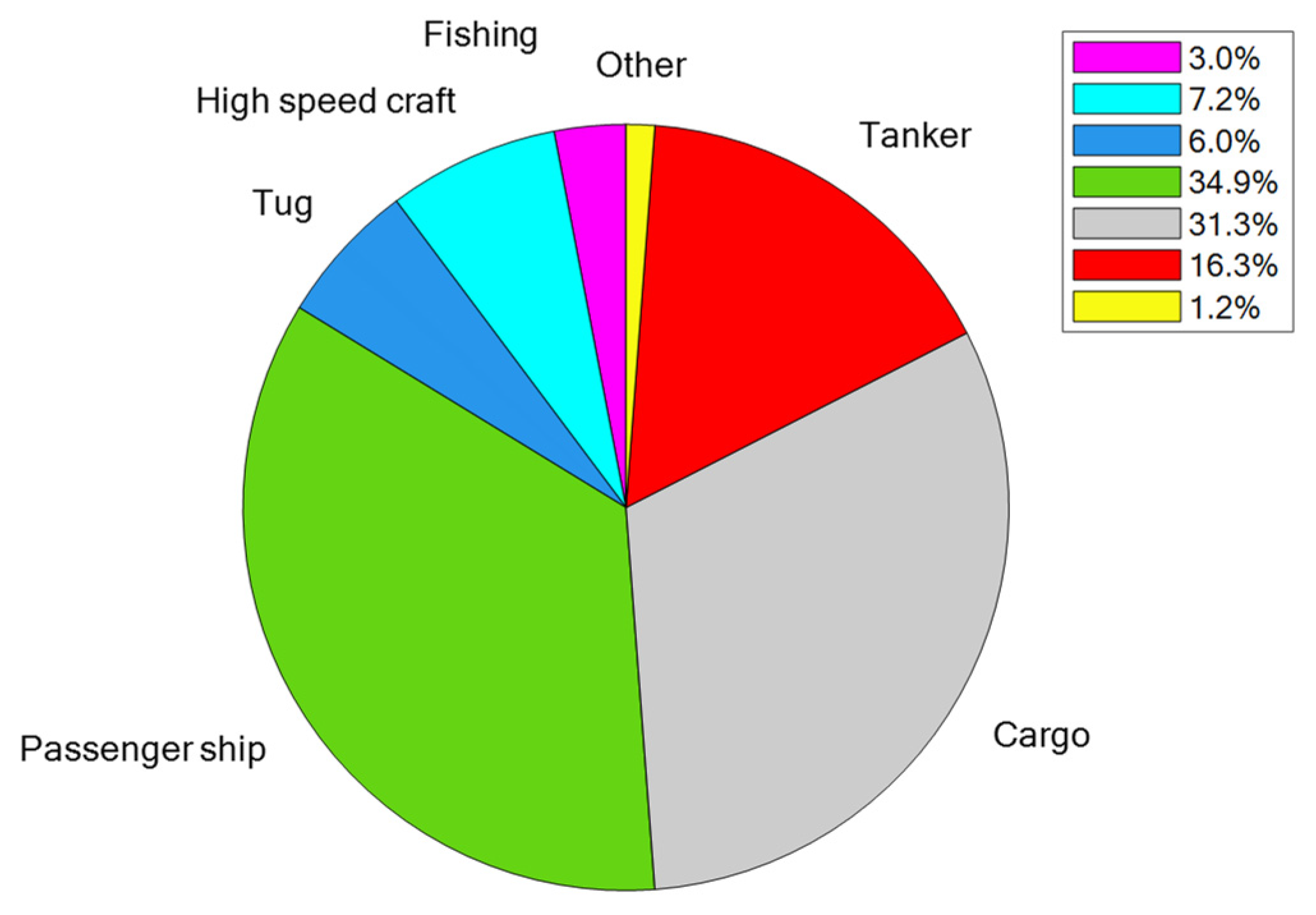
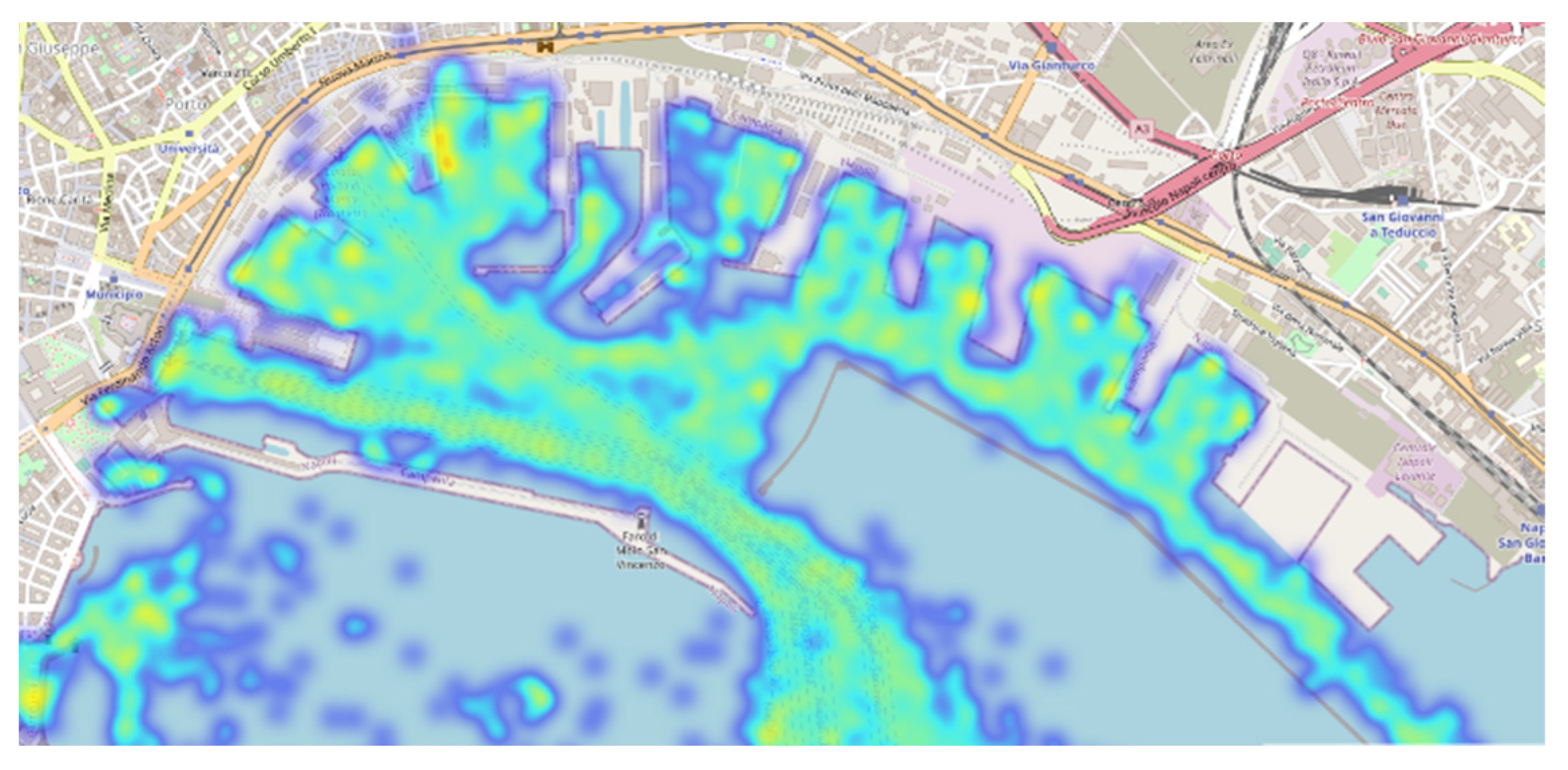


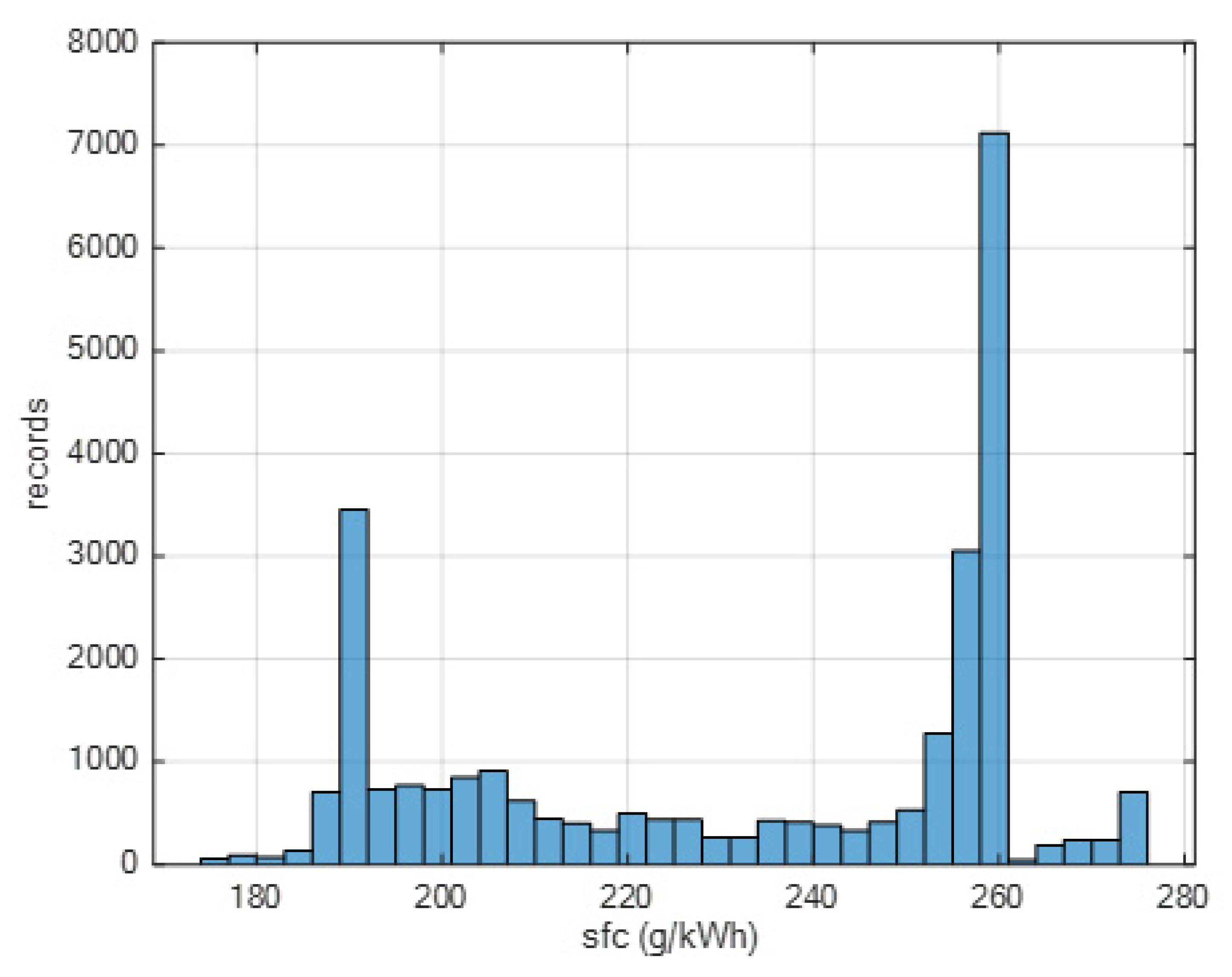


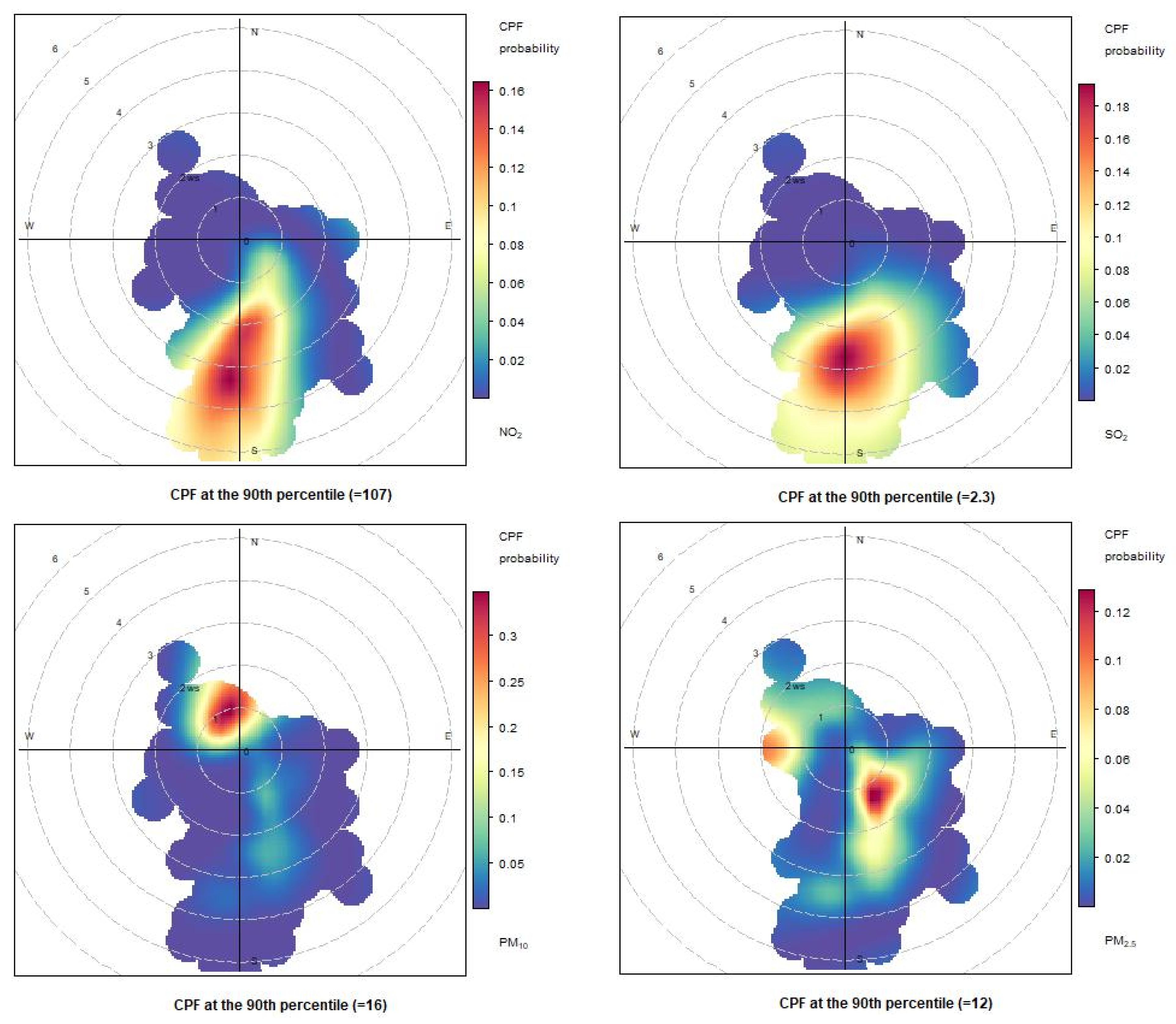
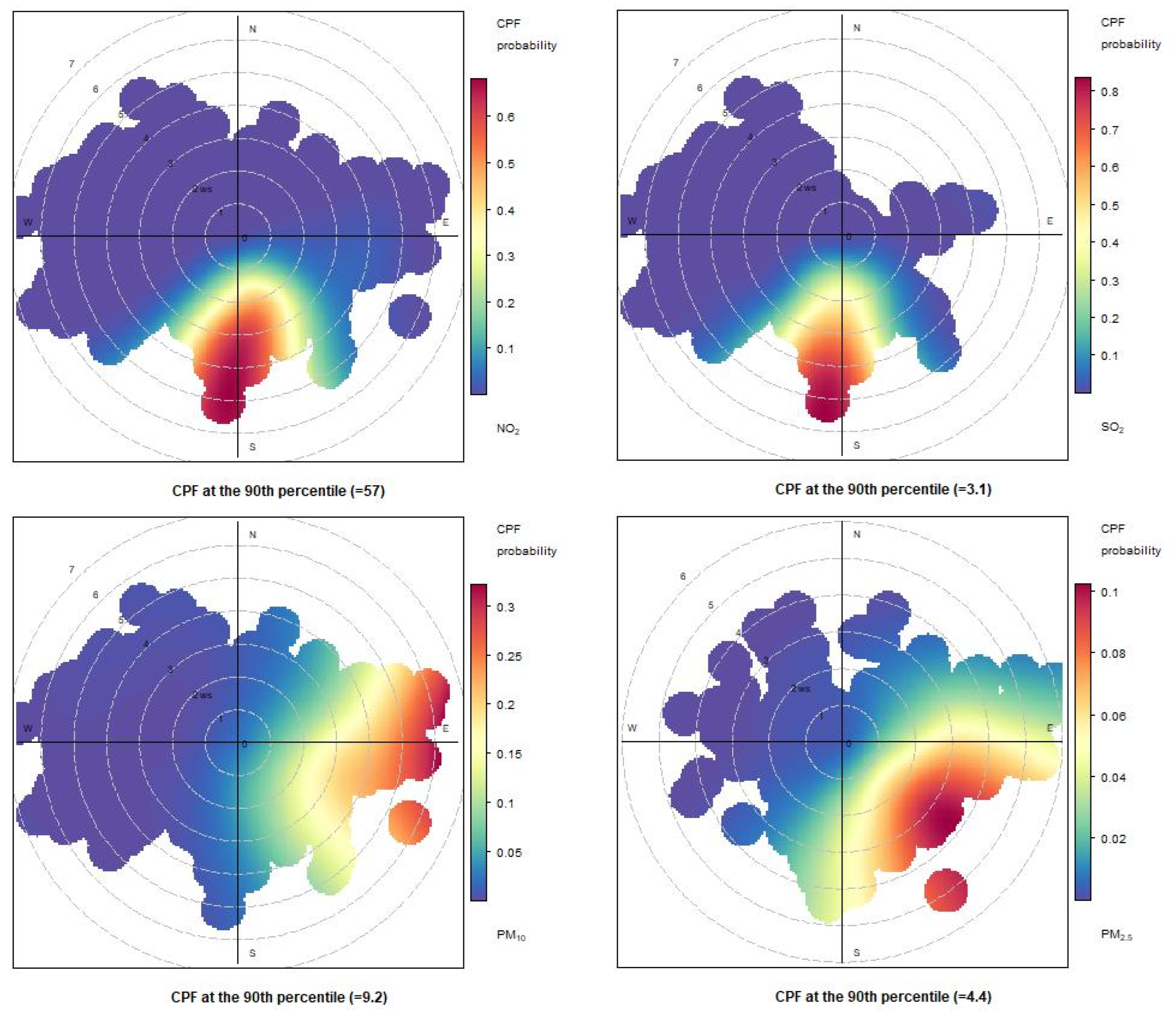

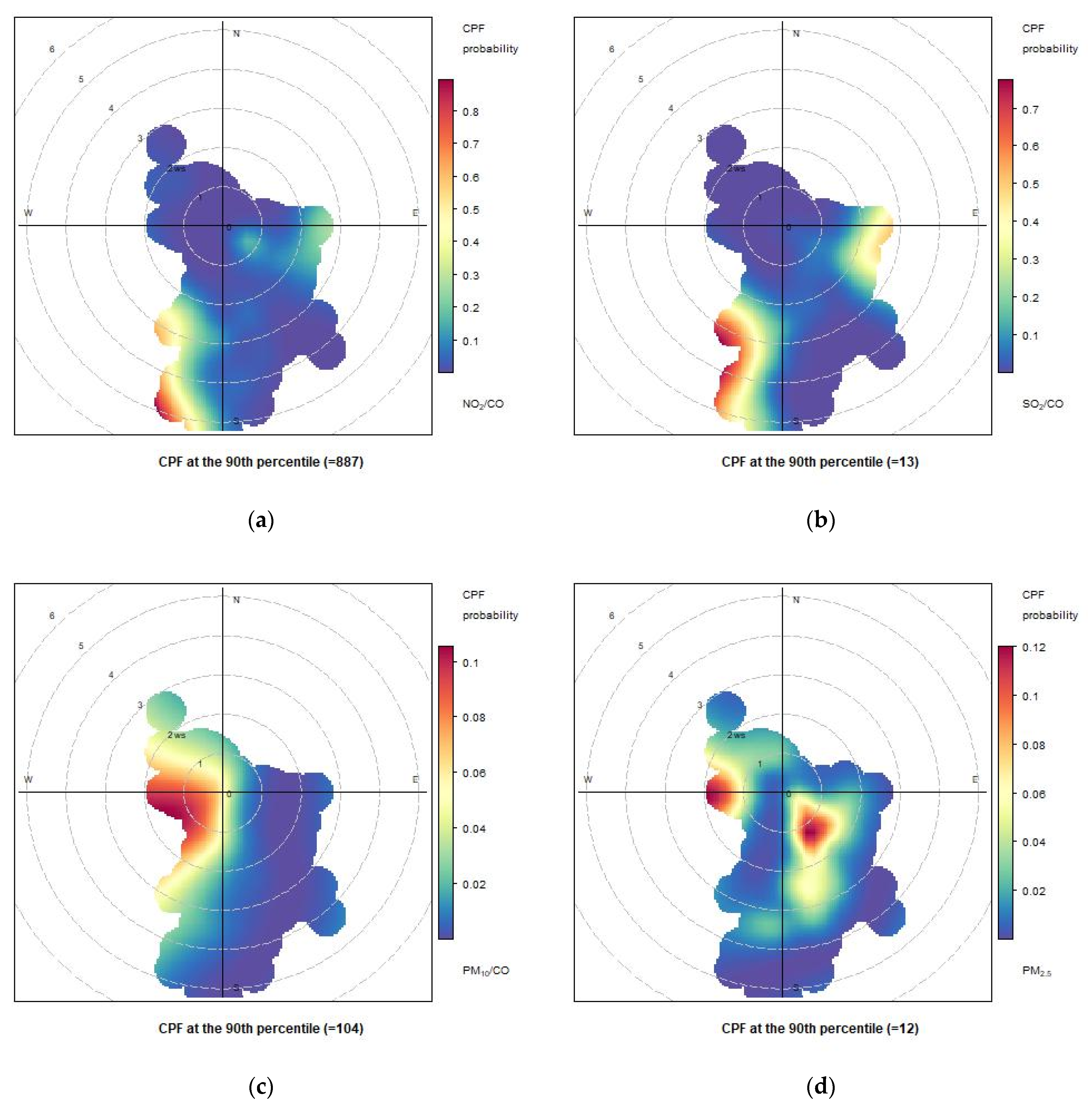


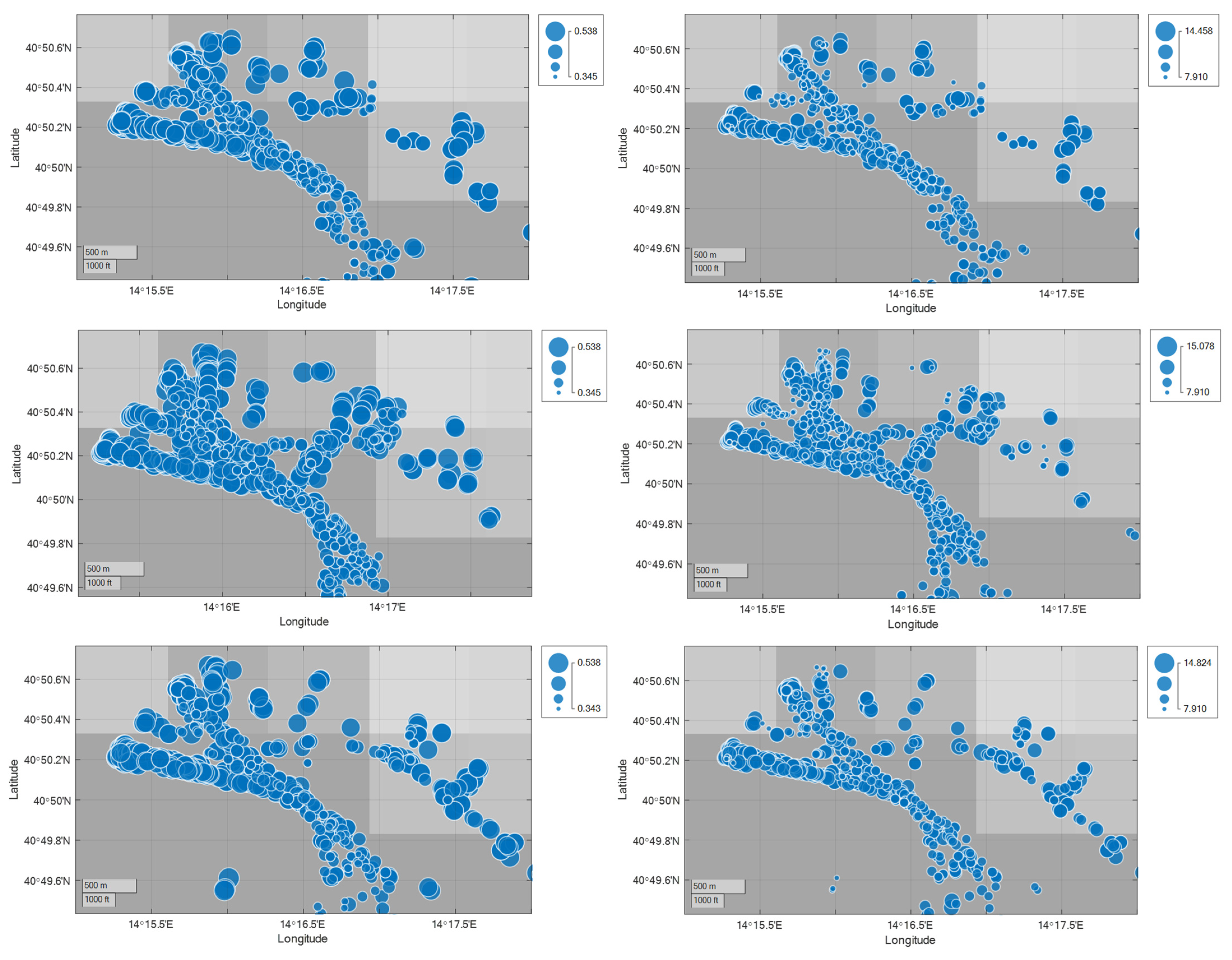
| SCT | 29 May 2021 | 31 May 2021 | 2 June 2021 |
|---|---|---|---|
| Fishing vessel | 0 | 2 | 2 |
| High-speed craft | 7 | 6 | 6 |
| Tug | 3 | 5 | 5 |
| Passenger | 18 | 19 | 20 |
| Cargo | 4 | 5 | 5 |
| Tanker | 8 | 8 | 8 |
| Other | 0 | 2 | 2 |
| Total | 40 | 43 | 44 |
Disclaimer/Publisher’s Note: The statements, opinions and data contained in all publications are solely those of the individual author(s) and contributor(s) and not of MDPI and/or the editor(s). MDPI and/or the editor(s) disclaim responsibility for any injury to people or property resulting from any ideas, methods, instructions or products referred to in the content. |
© 2024 by the authors. Licensee MDPI, Basel, Switzerland. This article is an open access article distributed under the terms and conditions of the Creative Commons Attribution (CC BY) license (https://creativecommons.org/licenses/by/4.0/).
Share and Cite
Mocerino, L.; Murena, F.; Quaranta, F.; Toscano, D. Port Emissions Assessment: Integrating Emission Measurements and AIS Data for Comprehensive Analysis. Atmosphere 2024, 15, 446. https://doi.org/10.3390/atmos15040446
Mocerino L, Murena F, Quaranta F, Toscano D. Port Emissions Assessment: Integrating Emission Measurements and AIS Data for Comprehensive Analysis. Atmosphere. 2024; 15(4):446. https://doi.org/10.3390/atmos15040446
Chicago/Turabian StyleMocerino, Luigia, Fabio Murena, Franco Quaranta, and Domenico Toscano. 2024. "Port Emissions Assessment: Integrating Emission Measurements and AIS Data for Comprehensive Analysis" Atmosphere 15, no. 4: 446. https://doi.org/10.3390/atmos15040446








